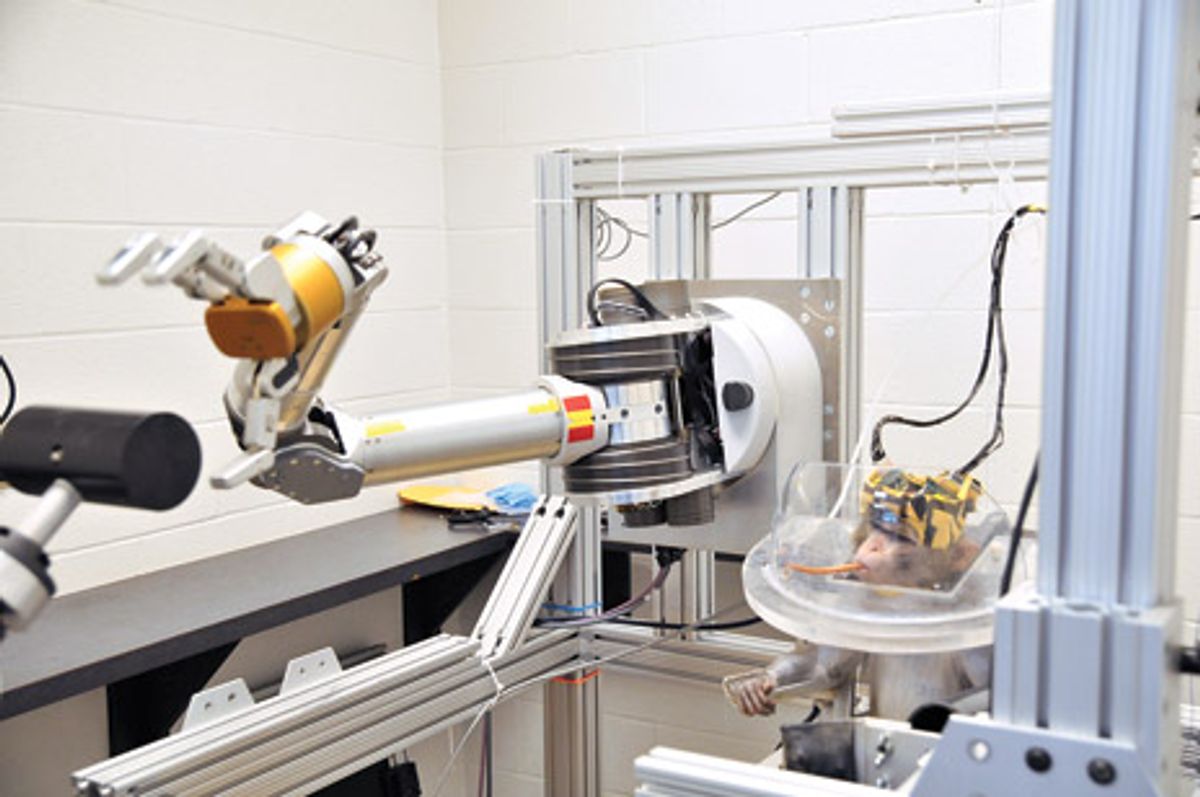In a remarkable demonstration of brain-machine interface technology, researchers at the University of Pittsburgh have taught a monkey to use just its thoughts to control an advanced robotic arm and perform elaborate maneuvers with it.
It's not the first time a monkey with sensors implanted in its brains has controlled machines with its mind. But this seven-degrees-of-freedom robot arm is probably the most complex system a monkey has ever mastered with its thoughts alone.
Researchers have long been working to put the brain in direct communication with machines. The hope is one day brain-machine interfaces will allow paralyzed people to operate advanced prosthetics in a natural way. Recent demonstrations have seen animals and humans controlling ever more complex devices.
But the experiments at the University of Pittsburgh, led by Dr. Andrew Schwartz, a professor of neurobiology, appear to involve an unprecedented degree of complexity in terms of the robotic arm, the level of control, and the difficulty of the manipulations demonstrated. Watch:
The video above shows the experiment. Note the monkey on the right side of the screen. It uses its right arm to tap a button. (Its left arm is gently restrained inside a tube.) This triggers the robotic manipulator labeled DENSO [left side of the screen] to position a black knob at an arbitrary point in space. The monkey then controls its articulated robotic arm to grasp the knob.
After gently touching the knob, the monkey places its mouth on a straw: it then gets a drink reward. (Actually, the animal places its mouth on the straw before even touching the knob; that's because it has learned, from repetition, that it's about to get the reward.) After that, both robotic arms reset. Again, the monkey taps the button, waits for the knob's new position, and readily and precisely moves its robotic arm to get a drink.
In this experiment, the monkey received two brain implants: one in the hand area and another in the arm area of its motor cortex. The implants monitor the firing of motor neurons and send this data to a computer, which translates the patterns into commands for the robotic arm.
In a previous study two years ago, Dr. Schwartz and his team taught a macaque to control a simpler mechanical arm to feed itself. This was a four-degrees-of-freedom arm with shoulder joints, an elbow, and a simple gripper.
Now the researchers have added three more degrees of freedom by adding an articulated wrist, which can perform roll, pitch and yaw movements. And the arm itself was replaced by a larger and nimbler manipulator. Although the video doesn't show it, the monkey can not only touch the knob but also precisely turn it by rotating the mechanical wrist.
Dr. Schwartz was kind enough to share this much with us, but he says more details will have to wait until he and his colleagues publish their results. We'll be waiting.
Photo and video: Dr. Andrew Schwartz/University of Pittsburgh
Erico Guizzo is the director of digital innovation at IEEE Spectrum, and cofounder of the IEEE Robots Guide, an award-winning interactive site about robotics. He oversees the operation, integration, and new feature development for all digital properties and platforms, including the Spectrum website, newsletters, CMS, editorial workflow systems, and analytics and AI tools. An IEEE Member, he is an electrical engineer by training and has a master’s degree in science writing from MIT.




